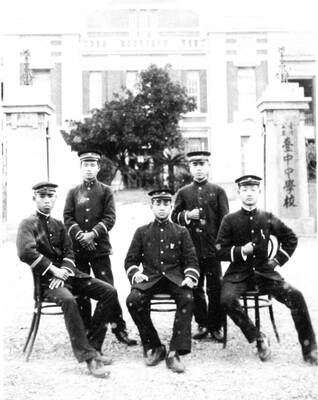It's rare to recommend the end of a concert, but it was the best thing about Aida Gomez Theater Dance Company's Salome, a Spanish romp through the biblical tale of breaking taboos, at Sun Yat-sen Memorial Hall (
After a terrible start, a cumbersome middle and an exciting end, the final curtain surprisingly prompted an exuberant appreciation of the cast's efforts.

PHOTO COURTESY OF KHAM
At first the audience clapped politely rather than with great enthusiasm at the conclusion of the performance. But then it found a rhythm and individual performers were inspired to do some impromptu dancing.
Once it started, the next dancer wanted to outdo his predecessor, until Nicolas Philippe Maire (St John the Baptist), a Royal Ballet School graduate, practically stole the show with some sweeping moves and dramatic extensions.
It was riveting stuff, and most of the crowd stood in appreciation, clapping all the time, engaged by the spontaneity of the dancers, who were equally lifted by the audience's participation.
But to begin at the beginning.
Clearly there was not enough material in Salome for a two-part show, so the first half consisted of a seemingly unconnected series of tableaux, presumably intended to show off Spanish flamenco in its purest form, with just dancers and mainly piped guitar music.
You could see everyone who did not buy a program looking at each other, thinking, "Is this the story of Salome?" It wasn't.
Throughout the entire 30 minutes of the first act, latecomers filtered into the auditorium, disrupting the dancers' concentration and irritating those already seated.
It was a horrible start to the show, which promised high production value, Spanish dancing from a legend of the flamenco stage and the staging of the Salome story by renowned director Carlos Saura -- famed for his film version of Georges Bizet's Carmen.
Whether it was because of the heated argument between organizers during the break or the fact that everyone had at last arrived, 45 minutes after the start, but the doors stayed firmly closed during the second half of the performance. The theater-goers who arrived late were presumably the same ones who tried to leave early, but were not allowed out.
On a side note, the Sun Yat-sen Memorial Hall should come up with a policy of being firm with late arrivals and give them a comfy seat from which to watch the show on TV monitors, outside the auditorium. This is standard practice elsewhere.
The main entertainment, Salome, was Riverdance for latin culture fetishists, with tap dancing and the addition of archetypal flamenco poses (arched backs, jutting butts, arms and hands outstretched).
This is not necessarily a bad thing, but it took a while for the performers to warm up and there were some jarring moments. The music veered from latin to eastern to Hollywood's Curse of the Pharaoh; Herod was pushed around the stage in a barely converted wheelchair meant to represent his throne; and overall, the stage was too big for the relatively small cast of 16 dancers. The lighting was unremarkable, except for the strobe spotlights in one of the scenes.
Still, there was dramatic tension and it came to a head with the Dance of the Seven Veils, by Aida Gomez, one of Spain's most famous dancers and the founder of her eponymous company. The solo climaxed with Gomez baring all.
St John the Baptist ended up rolling around the stage with a silver platter around his head to represent his head being chopped off and a so-so show was over, or so we thought, until the encores.
Salome is playing at the Hsinchu Municipal Auditorium (新竹市立演藝廳) tomorrow; in Kaohsiung, at the Performance Arts Hall (高雄至德堂), on Saturday; and Nov. 9 at Taichung's Zhongshan Hall (台中中山堂). All shows start at 7:30pm and tickets are NT$400 to NT$2,000, available through Kham Arts.

In the March 9 edition of the Taipei Times a piece by Ninon Godefroy ran with the headine “The quiet, gentle rhythm of Taiwan.” It started with the line “Taiwan is a small, humble place. There is no Eiffel Tower, no pyramids — no singular attraction that draws the world’s attention.” I laughed out loud at that. This was out of no disrespect for the author or the piece, which made some interesting analogies and good points about how both Din Tai Fung’s and Taiwan Semiconductor Manufacturing Co’s (TSMC, 台積電) meticulous attention to detail and quality are not quite up to

April 28 to May 4 During the Japanese colonial era, a city’s “first” high school typically served Japanese students, while Taiwanese attended the “second” high school. Only in Taichung was this reversed. That’s because when Taichung First High School opened its doors on May 1, 1915 to serve Taiwanese students who were previously barred from secondary education, it was the only high school in town. Former principal Hideo Azukisawa threatened to quit when the government in 1922 attempted to transfer the “first” designation to a new local high school for Japanese students, leading to this unusual situation. Prior to the Taichung First

Chinese Nationalist Party (KMT) Chairman Eric Chu (朱立倫) hatched a bold plan to charge forward and seize the initiative when he held a protest in front of the Taipei City Prosecutors’ Office. Though risky, because illegal, its success would help tackle at least six problems facing both himself and the KMT. What he did not see coming was Taipei Mayor Chiang Wan-an (將萬安) tripping him up out of the gate. In spite of Chu being the most consequential and successful KMT chairman since the early 2010s — arguably saving the party from financial ruin and restoring its electoral viability —

The Ministry of Education last month proposed a nationwide ban on mobile devices in schools, aiming to curb concerns over student phone addiction. Under the revised regulation, which will take effect in August, teachers and schools will be required to collect mobile devices — including phones, laptops and wearables devices — for safekeeping during school hours, unless they are being used for educational purposes. For Chang Fong-ching (張鳳琴), the ban will have a positive impact. “It’s a good move,” says the professor in the department of